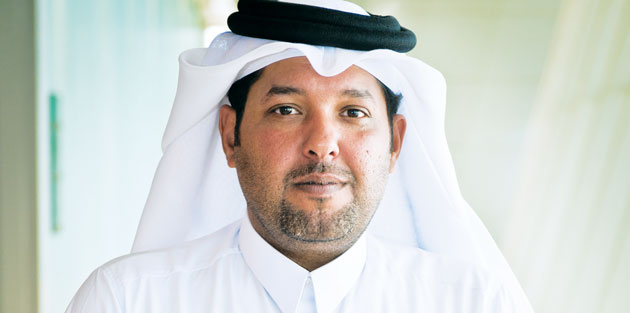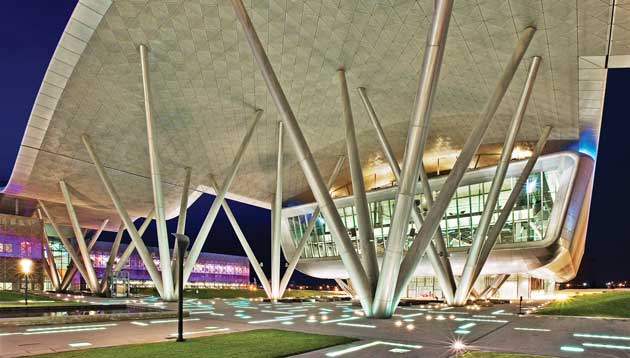QSTP: Qatar’s gateway to industry
As a facilitator of applied research and a free zone, the purpose of Qatar Science and Technology Park (QSTP) is to foster a spirit of innovation. Talking exclusively to The Edge, Hamad Al Kuwari, managing director of QSTP says that each of the functions of the park are aligned with the aims and strategies drawn up in the Qatar National Research Strategy.
 QSTP licensees are allowed 100 percent foreign ownership and are not taxed on their income, this has been a crucial reason why so many companies exist within QSTP, says Hamad Al Kuwari, managing director QSTP.
QSTP licensees are allowed 100 percent foreign ownership and are not taxed on their income, this has been a crucial reason why so many companies exist within QSTP, says Hamad Al Kuwari, managing director QSTP.Environment, energy, health sciences and ICT are the focus areas of QSTP. How would you break down the initiatives that are included in each of these areas?
QSTP’s vision is to be an international hub for applied research, innovation and entrepreneurship, an active and supportive free zone, and a facilitator of technology commercialisation. These are the three charters of QSTP, and as part of the bigger umbrella of Qatar Foundation Research and Development (QF R&D), QSTP focuses on the end products of research. To that extent, research endeavours of higher maturity, which can be and need to be commercialised, fall within the ambit of QSTP.
We are governed by the Qatar National Research Strategy (QNRS), a strategy document that lays down clear direction in all four research areas of QSTP: energy, environment, computing or ICT and health sciences.
In Qatar, being primarily driven by oil and gas, you can expectantly find a higher percentage of energy-related entities at QSTP. This, however, does not rule out the presence of alternative energy and now ICT and health sciences enterprises under the same roof.
How many of the research programmes in these four areas are on the path to commercialisation? What role does the QSTP play?
Commercialisation has two aspects to it. One, the patents or technologies that are developed by the members of QSTP and two, those that are funded by them. For the second category, it is the members’ responsibility to actually commercialise them. However, in the first case, QSTP conducts technology assessment and gives advice on the best commercialisation route. This means giving tenants options such as starting up a new company or simply licensing the technology out. Our advice depends on the technology and its readiness.
How do the goals of QSTP tie in with the Qatar National Vision (QNV) 2030?
QNV 2030 is the overarching vision that lays down and defines the main thrust areas of the country as a whole, within which there are a number of different initiatives. The R&D aspect under the QNV 2030 is addressed by the Qatar National Research Strategy (QNRS). QSTP is one of the vehicles for the QNRS, contributing to the overall strategy. In effect, there is a direct correlation between what QSTP does to support incubation, innovation and commercialisation – all of which contribute to the overall strategy and thus to the vision itself.
QNV 2030 is often discussed in the context of economic diversification beyond oil and gas, though I personally think that the description is limiting. It could well and often does relate to technologies that enhance and fine-tune the recovery and processing of gas to have less of an impact on the environment.
“QSTP conducts technology assessment and gives advice on the best commercialisation route.”
Within the umbrella of QSTP, there are diverse entities. How does QSTP manage diversity and drive research initiatives and deliver technology that can potentially be commercialised?
The entities within QSTP are mandated to undertake technology development and are governed by the free zone law and regulations, which allow us to issue them licences to operate, and create a favourable framework with potential tenants. Usually, the framework is industry-specific and there are agreed-upon activities with entities regarding what they are planning to do in a given timeframe.
At the end of each year, there is an evaluation exercise where QSTP assesses the performance of the entity. The evaluation exercise helps us ensure entities achieve what they set out to achieve and that we are providing the right support.
Monitoring is one way, yet when an application for tenancy comes, how do you ensure that it is focused on QNRS?
The discussion we have with potential tenants is thorough enough to ensure the entity will be contributing to specific goals within the QNRS. We distinguish ourselves as a science and technology park by focusing on these key areas. We have a process for tenancy which focuses on how one applies, based on which we grant licences to the entities. Besides the free zone department, we do have a strategy research department, which consists of professionals, in the four schematic areas.
A post-carbon economy is one of the thrust areas of QSTP. How will, in an economy, which is still driven substantially by oil and gas, will a science park be able to take the country into that phase?
The post-carbon economy is an effective vision, in my opinion, one that is challenging yet achievable. This keeps up the momentum and makes people work towards it. Moving Qatar’s economy into a post-carbon phase is a vision for QSTP and I believe it can be done with the huge commitment by the government, which provides a massive 2.8 percent of its GDP to R&D, one of the highest in the world.
There is an ambitious plan for the country’s R&D that is encapsulated in the QNRS and overall ambit of QF. This makes QSTP an important player in realising the vision for the simple reason that the output of the research comes to QSTP for commercialisation. If we were to coin a slogan for QSTP, it would be: The gateway to industry.

The QSTP is currently at 95 percent occupancy, but is has plans to expand the technology park with the addition of two new buildings.
With Qatar having an increased focus on solar power (following what was declared at the COP18 held in 2012) and with the new testing facility here within QSTP, what have been the advances made?
The solar testing facility is a collaborative effort between a home-grown start-up called Green Gulf and Chevron Energy Solutions. The whole mandate of this facility is to test the different types of solar technologies and that would include photovoltaic energies, specifically those that are applicable to this region. However, we have been testing since the inauguration in December 2012. It was inaugurated by Her Highness Sheikha Moza bint Nasser, the chairperson of QF. Our goal is to obtain enough data to generate concrete, knowledge-based conclusions.
A question that needs to be borne in mind is, though Qatar and the region have plenty of sun, is: do we have the correct type of sun? This is precisely what we are trying to answer with the fully-instrumented testing facility which takes cognisance of high temperatures, high humidity, and high dust erosion - factors that impact the performance efficiency of solar panels in the region.
When inviting new members from across the globe, what do you normally look for? And how does QSTP help a new tenant?
Initially, when QSTP is trying to attract tenants, the first things we look at are the sectors Qatar needs. Once the sectors are identified, we start looking at the objectives of the research strategy. Once these are satisfied, we look at how those entities might build synergies – through their work here in Qatar - based on their core competence and how it could be applied elsewhere. Currently, we are at 95 percent occupancy and are not doing roadshows anymore to attract people until the new buildings are constructed.
Once a tenant is on board, we support them in many ways. Besides the infrastructure that is available to them, we support them by helping them understand Qatari regulations, government agencies including customs and immigration, and simple things like how to get a phone connection. Some of this support we provide ourselves and for some, we direct them to the right entities that are aware of, for instance, the free zone and what exemptions we as the science and technology park can extend to foreign players.
2.8% - Percentage of Qatar’s GDP devoted to R&D.
How did the free zone help attract companies into QSTP?
The free zone is a crucial element and a key reason why there are so many entities within QSTP, because it allows QSTP to license companies that are 100 percent foreign-owned, with no taxation on their income or on imported goods that are used for technology development. These benefits allow foreign direct investments in the field of technology here in Qatar.
What have been the most important milestones since the QSTP opened? What do the next four to five years look like?
We are in our next phase of physical growth, having launched the design phase of the second stage of development within QSTP.
The plan is to have two more buildings within the park, all within the free zone. We will have a technology building, which will be similar to Tech 1 and Tech 2. But this building will incorporate the feedback we received from our members, namely enhanced functionality of the building. We will also have Tech 4 which is going to be more of a workshop where tenants who require heavy-operation testing, will be housed.
Also, in these four-plus years, we have been able to define a culture that befits a science park. Today, having 42 companies is a testament to the work we have done convincing people to come undertake technological development in Qatar and the value they have gotten from it.
We went about building this entire infrastructure and making sure it is actually occupied with people who are involved with technology development. As a strategy, we went about developing the infrastructure stage by stage, instead of having the entire infrastructure in place and then struggling to have our facilities occupied. That was the focus for the first five years – how to attract companies, how to make synergies, how to build relations with QF and create a balance between the producers of technology and its end-users. QSTP has also had to work on building relationships and synergies with government agencies and the local private sector.
Building relationships, internally and externally, has been a key focus here.
Last year, we won the bid to host the International Association of Science Parks and Areas of Innovation’s 31st Annual World Conference - a conference where all science parks around the world participate. It will be held here in Doha next October at the Qatar National Convention Centre. This event will allow everyone to share their experiences, find out what the challenges are, some of which are common, and some region-specific.
Like this story? Share it.





